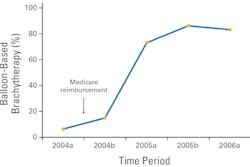GRAPEVINE, TX - For years, the conventional wisdom was that radiology practices needed to increase volume to stay afloat. But federal healthcare reform legislation passed last year, as well as the current debt ceiling crisis, may be changing that equation, according to a presentation at this week's AHRA meeting.
The problem of how to provide and pay for healthcare has been with us for a while -- at least since 1964, when Medicare was established, according to speaker Robert Still, president-elect of the Radiology Business Management Association (RBMA) and practice manager at Lancaster Radiology Associates in Pennsylvania.
And because people are living longer (in part because of the very advanced imaging procedures the feds want to cut, he believes), there are more and more people who will need care: In 2010, there were 46.6 million Medicare beneficiaries; in 2030, there will be 77.2 million, Still said.
"In 2030, almost 20% of the U.S. population will be over 65," he told session attendees. "We cannot afford this -- and that's the problem."
So the healthcare game is shifting, and radiologists and hospital administrators had better figure out the new rules quickly, Still said. The 2010 Patient Protection and Affordable Care Act's (PPACA) call for healthcare savings has created what Still dubbed as "the new hospital reality show."
"The terms of the game have long been that the more volume we perform, the more we bill, the more we get paid," Still said. "Now we're going to have to work with others and share the savings."
Share the love
The PPACA has mandated three ways of cutting costs: bundled payment demonstration projects, accountable care organizations (ACOs), and value-based reimbursements. It behooves radiology administrators to familiarize themselves with each of these, Still said.
Bundled payment demonstration projects
The PPACA allocated $1.1 billion in funds for bundled payment demonstration projects, in which hospitals receive a single payment to cover hospital and physician services for a particular diagnosis-related group, or DRG. The goal is to align physician and hospital payments, encourage coordination of care, improve quality of care, and contain costs by eliminating unnecessary readmissions, Still said.
"Now that is a meeting I would like to attend: The one where everyone is trying to figure out how to divvy up the pie," he said. "My advice? Learn as much as you can about bundled payments."
ACOs
Accountable care organizations are cost-cutting vehicles intended to "provide an opportunity for Medicare beneficiaries to receive high-quality, evidence-based healthcare that eliminates waste and reduces excessive costs through improved care delivery," according to a U.S. Centers for Medicare and Medicaid Services (CMS) fact sheet. And as part of the ACO framework, the PPACA also will establish a program penalizing hospitals for preventable readmissions, Still said.
"I thought [providing high-quality, evidence-based healthcare] was what we all do on a daily basis," he said. "Haven't we been doing this for years? In any case, Medicare is going to start penalizing hospitals for preventable readmissions -- and 'preventable' is a pretty broad term."
Value-based reimbursements
The PPACA seeks to link reimbursements and "value" not only through physician quality reporting initiatives (PQRIs) and by establishing levels of achievement (based on a percentage of a hospital's base DRG payment per discharge), but also through a shared savings program that starts in 2012. The program is designed to encourage physicians and hospitals to coordinate patient care and improve communication with each other, Still said.
"The key is getting each Medicare beneficiary the right care at the right time, and making sure that the care is provided right the first time," he told session attendees. "Is that the right study? Is that study needed now? Would a more expensive study work better than a bunch of less expensive ones?"
Shared savings will be based on a quality performance scoring system of five "domains," under which various measures are scored, with the percentage of points earned for each domain aggregated to arrive at a single percentage that will determine the sharing rate for a particular ACO. The domains include:
- Patient/caregiver experience
- Care coordination
- Patient safety
- Preventive health
- At-risk population/frail elderly
Under each of these categories is a list of measures for which points can be accrued, Still said. Gone are the days of working solo as a radiology department, he added.
"This is the new hospital reality show, and what you're going to win is shared savings," Still said. "We don't work this way right now, and that's going to have to change. The more points you have, the more the hospital gets paid. We've got to pick the right studies, and do them right the first time."
And another thing
Also on the federal radar is managing advanced imaging costs through clinical decision-making support and the equipment utilization rate, which could jump from its current 75% to 90% or 95%, Still said.
"Congress knows what the projected savings to the Medicare program are from using radiology benefits management companies," he said. "And certainly in the debt ceiling conversation, they're looking for things to cut that already have a price tag on them."
It all boils down to a particular scenario: that of imaging being driven back to hospital settings, Still concluded.
"New measurement metrics will be developed by all providers, and quality, service, and productivity will become even more critical," he said. "There's never been a better moment to do the right imaging exam at the right time in order to stay in the game."




















